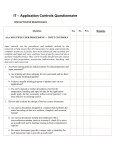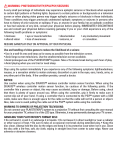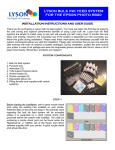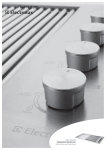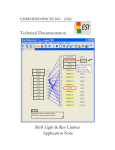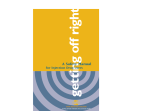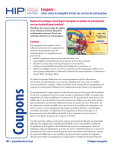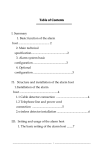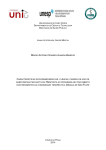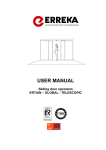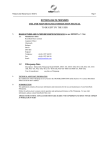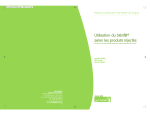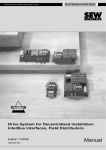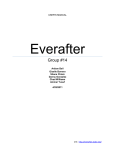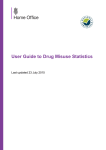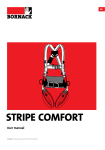Download Safer Injecting Guide
Transcript
SAFER INJECTING
...reducing the harm associated with injecting drug use...
CONTENTS
This guide is aimed at people who
inject drugs to help reduce some of
the problems caused by injecting.
It includes information on safer injecting
practices and types of injecting.
Advice on how to find a vein and the
equipment that should be used.
Recommendations on how to best care for
your veins, avoiding vein damage and when
you may need to seek help.
Safer Injecting Tips
4-5
Types of Injecting: Into the vein
6-7
Types of Injecting: Skin popping
8-9
Types of Injecting: Into the muscle 10-11
Finding a Vein 12-15
Vein Care 16-17
Vein Damage 18-19
Strategies for coping with overdose and
information on HIV and hepatitis (Hep) B &
C.
Front & Back Loading 24-25
Suggestions of alternatives to injecting and
advice in relation to poly drug use.
Get Help If... 26-27
Finally, there are details of where you can
get further information.
Works 20-23
Overdose 28-29
HIV/Hep C 30-31
Alternatives to Injecting 32-33
Polydrug Use 34-35
Further Information 36-37
4
5
SAFER INJECTING TIPS
ways to reduce risks
Remember before you inject
• Get your own works from your local needle
exchange.
• Ask in your needle exchange for syringe
markers/ID’s.
• Never share needles or works with another
drug user not even your partner, boyfriend or
girlfriend.
• Try not to use alone.
Use syringe ID’s
Remember when injecting
• Wash your hands first.
• Don’t lick the needle. There are bacteria in
your mouth which can get on the needle.
• Always inject yourself.
• Take your time. Rushing can mean you make
a mistake.
• If sore take the needle out and start again,
always using a clean needle.
• Do not swab the area after injecting, just
apply pressure.
• Front or back loading is only ok if all
equipment is known to be previously unused.
(see page 24)
• If there is clotted blood in syringe consider
using the ‘up your bum’ method. (see page
32)
• Learn to inject with both hands.
Always wash your hands
Did You Know?
MQI run
Safer Injecting
Workshops.
Ask staff for more
information.
TIP:
Avoid mix-ups, always mark your syringe
6
7
TYPES OF INJECTING
into the vein
{intravenous}
Remember
• Always inject in the direction of the heart.
• Never inject into a pulse. A pulse means an
artery.
• Always follow safer injecting tips.
(see page 4)
• Vein care is very important.
(see page 16)
Risks:
• Blood borne viruses HIV, Hep B & C and
many other health problems.
• Abscesses, infections, blood clots & Deep
Venous Thrombosis (DVT).
• Overdose: Make sure to test the dose and
don’t inject alone.
• There is as high risk of gangrene if you
inject into a pulse/an artery...
Always inject in direction of heart
If you hit a pulse/artery blood will be bright red
and you may feel pressure against the plunger.
Apply pressure for 15 mins, raise the affected limb and
go to your G.P/or Local Health Centre. If it won’t stop
bleeding or you are worried call 999.
Recommended needle size:
Baby brown for hands and feet.
Brown and diabetic for arms.
(Ask staff for more information)
Did You Know?
Injecting into any
vein is also called
mainlining.
TIP:
The bigger the needle size the greater the
chance that you will damage your veins.
8
9
TYPES OF INJECTING
skin popping
{subcutaneous}
Remember
• The drug is slower to take effect when
you use this way, so be patient.
• It is suitable for short-term use only
as any bacteria or irritant (e.g. citric
or vitamin c) lies close to the skin
surface and easily causes abscesses and
infections.
• Always follow safer injecting tips.
(see page 4)
• Very important to rotate the injecting
sites.
Risks
• Drug absorbed slowly. This can give
germs time to damage skin near where
needle went in.
• It can cause abscess and infections easily.
• Always inject yourself.
• May lead to lumps and bumps and long
term damage.
inject just below the skin
Recommended needle size
Diabetic.
upper arm
stomach
thigh
Did You Know?
Skin Popping
is injecting just
under the skin.
TIP:
Always swab the area before injecting.
10
11
TYPES OF INJECTING
into the muscle
inject deep into muscle
{intramuscular}
Remember
• This can leave the muscle sore and stiff.
• The drug is slower to take effect when you
use this method.
• It is not a good choice for using a lot.
• Always follow safer injecting tips
(see page 4)
• Steroids are used this way.
• Contact your local needle exchange for
more information.
Risks
• Deep painful abscesses.
If the wrong needle size is used there is risk of the
needle snapping because the muscle tenses
as you inject.
If this happens go straight to the
local Accident and Emergency Department.
Recommended Needle Size
Green and Blue. Depends on your muscle
mass. Ask staff.
upper arm
hips
thigh
Did You Know?
intramuscular
involves injecting
deep into the
muscle.
TIP:
Avoid injecting into the butt/bum muscles as
you can’t see if you are doing any damage.
12
13
FINDING A VEIN
NECK - this is a high risk area
• There is a big vein and a big artery here.
RISKS:
• Hit the big artery and you could have severe bleeding.
• Swelling blocking your airway.
• Clots in your big vein very near your heart which could stop you
breathing.
• Nerve damage and potential for an abscess in the neck.
ARM
• The lower you start the longer the veins will last.
RISKS:
• Absesses & infections.
• Missed hits.
HAND
• Avoid use of fingers and palm of hand.
• Remember to take your rings off.
• Hands have thin veins, be gentle.
• Do not use wrist - big artery, veins, and nerves here.
RISKS:
• If you leave a ring on, the swelling can stop the flow of
blood and you could lose a finger.
TIP:
If you have to try a few times to find a vein
always use a clean needle for each attempt.
14
FINDING A VEIN
15
GROIN - this is a high risk area
RISKS:
• Huge vein, nerve and artery into the groin. They crossover
each other.
• Hit the big artery and you could have severe bleeding.
• Lots of germs here that can be passed into the body when
injecting.
• Other risks include abscesses, blood poisoning, and loss of limb
due to gangrene.
LEGS - this is a high risk area
RISKS:
• Are difficult to access especially behind the knees. They don’t
usually last for long.
• Injecting into varicose (swollen veins on legs) leads to ulcers.
• Risks of long-term abscesses, leg swelling and other infections.
• The highest risk of clots are in the legs.
FEET - this is a high risk area
RISKS:
• Lots of germs here. Swab well.
• Small veins so inject slowly. Only use short-term. Can lead
to very painful feet.
• Infection and swelling. This can be very slow to heal. Seek
medical help.
TIP:
The penis, the armpit and breasts are also
particularly dangerous sites.
VEIN CARE
16
FIBROSED VEIN / collapsed vein
Remember
• Start as low as possible.
• Use tourniquet which is elasticised. Do
not use a lace or belt as this can twist veins.
Tourniquets available in MQI.
Everytime you inject you
damage your vein.
• Use small needle as this will cause less
damage to vein.
• Where possible use new needle and syringe
and sterile water every time.
• If you have to reuse a syringe, only reuse
your own.
• Inject slowly.
Repeated use causes scars to form.
• Remove needle slowly to prevent vein
collapse.
• Learn to inject with both hands.
• Always inject yourself.
• Use only a small amount of citric acid.
Continuous injection into a scarred
vein causes the vein to collapse.
TIP:
Rotate sites to let veins recover.
17
18
19
VEIN DAMAGE
Vein damage is caused by
• Repeated use of the same area/site.
• Using old needles or blunt needles.
do not flush
• Using wrong tourniquet.
• Flushing veins which can cause clots and
block veins. You do not get an extra buzz
from flushing.
• Using lemon or vinegar. This can cause
infections and lead to blindness or kidney
damage.
• Using too much citric will irritate and
damage the vein. Only use a small amount.
• Missed hits which occur when you miss the
vein and inject into the tissue surrounding
the area. This can cause an infection and
abscesses.
do not
inject
tablets
• Injecting tablets will seriously damage your
veins.
• See Vein Care (page 16).
TIP:
More advice at the Safer Injecting Workshop.
Ask MQI or your local needle exchange.
20
21
WORKS
Works means gear, spikes (needles), citric,
water, barrels (syringes), spoons, filters,
tourniquets, alcohol swabs and the surface
used to cook up.
syringe
Remember
• Viruses can live in any part of your works.
• Don’t assume that if it looks clean it is clean.
• Single use syringes are the safest as water
and/or bleach will not destroy all viruses.
filters
• Mark your spoon and tourniquet so you
don’t confuse them with someone else’s.
citric
• Always use a fresh filter.
• Always dispose of your works safely.
sterile water
• Return syringes, barrels and spikes and ask
for a sharps bin (sin bin) when you are next
in your local needle exchange.
metal spoon
TIP:
You do not have to see the blood for a
virus to be present.
22
23
WATER
• Use sterile water from the needle exchange.
Each vial is for single use only.
• If you have no sterile water. Boil your own
water and allow it to cool.
• Bottled water is not sterile (can be full of
bacteria) and should not be used.
Water
do not use
bottled water
Never use water from the toilet bowl.
This is full of germs.
CITRIC
• Only use a small amount of citric. Using
too much will irritate the injecting site and
damage veins.
• Each citric sachet is for single use only.
• Generally the amount in the citric sachets
is too much for one hit only use enough to
break down the heroin.
• Do not use lemon juice or vinegar. This can
cause infections and/or kidney damage.
do not use
LEMON
juice
If it is not breaking down it probably is not
heroin and you should not inject it.
Vitamin C
• Vitamin C/Vit C (also known as ascorbic
acid) can be used to break down heroin
however there is no evidence that it is better
than citric.
• The main difference is that you need to use
more Vit C than Citric. Citric is a stronger
acid.
• They can both cause vein damage.
• Vitamin C sachets are the best option. Use
as little as possible.
If you are using Vit C make sure it is
Ascorbic Acid BP (pure vitamin C).
vinegar
do not use
vinegar
24
25
Sharing drugs
front & backloading
Remember
• These are two common ways of sharing
drugs which should only be used if
all equipment is known to have been
previously unused.
DIVIDE UP
before you
cook up
• If anything that is used is not sterile
everyone is at risk.
• This is unsafe practice as it’s difficult to
ensure that everything in the other
person’s works is sterile.
• This involves drawing up the whole drug
solution, once prepared, into one syringe
which has a needle attached.
FRONTLOADing
• Then some of the solution is squirted back
into the other syringe/s either through
the front end where the needle is
removed (frontloading) or through the
back end where the plunger is removed
(backloading).
• It is safer to only use your own works.
backLOADing
TIP:
Divide up before you cook up.
26
27
Get Help If…
• You have cuts or wounds that need attention.
• The area around the injecting site is raised,
red, hot and painful.
Do not try
to lance
an abscess
yourself
• You think you have an abscess. Remember
do not cut it open as this can lead to blood
poisoning.
• You have painful, heavy, swollen and/
or dead leg. It may be DVT (Deep Venous
Thrombosis).
• You hit an artery and it wont stop bleeding.
• Your arm or leg is white, cold, or there is
a loss of sensation. Go to your local
Accident and Emergency department
immediately.
• If you have been jabbed accidentally by a
used needle go straight the local Accident
& Emergency.
Do not inject
near an
infected site
or lump
Where Help is available
•
•
•
•
The local Accident & Emergency
Your local GP
The local Health Centre
MQI’s Primary Care Unit
TIP:
If in doubt: Get it checked out
28
29
OVERDOSE
To reduce risk of overdose...
• Try not to mix drugs; some drugs increase
the strength (potency) of others.
• Look at alternatives to injecting
e.g. smoking.
• If you have been clean for a while remember
your tolerance will have dropped. Take a
test dose to get feel for the strength before
you inject the full amount.
• If you are using a new drug for the first
time also take a test dose.
• Try not to inject alone.
Signs of an overdose...
Someone has overdosed if they are...
• Not responding to pain.
• Breathing very slowly or have stopped
breathing.
• Starting to turn blue.
• Not coming around within three minutes.
What to do...
• If someone overdoses, don’t assume they’ll
come around. Call 999 immediately.
• Try not to panic.
• If they are breathing put them in the
recovery position. This stops them from
choking on vomit.
• If the person is not breathing, and you
know CPR try to resuscitate them.
• Stay with the person until help arrives.
RECOVERY POSITION
TIP:
Swallowed tablets take up to 4 hours to kick in.
Remember this if you are using more than one drug.
30
31
H.I.V and HEP B & C
H.I.V
• This is a virus which is passed on through
blood and body fluids.
• People can live a long life with HIV with
medical support.
Hep B and C
• Hep B and C are viruses that can live outside
the body.
• Hepatitis B & C are much more easily passed
on (infectious) than H.I.V.
• They are also passed on through blood and
body fluids.
Always
use a condom
Protect yourself...
• Know the facts. Information available on HIV,
Hep B & C in MQI and your local health
centre.
• Practice safer injecting techniques.
• Practice safer sex. Condoms are available
free of charge from MQI.
• If you and your partner, both have HIV
or Hep C, you can be passing different types
(strains) to each other.
• Cover cuts and wounds.
• Get a Hep B vaccination in MQI or other
Health Centres.
• Viruses can also live in snorting equipment
e.g. tooters, straws etc.
Cover cuts
and wounds
TIP:
Never share toothbrushes and razors as
viruses can live here also.
32
33
Alternatives
to Injecting
up the bum
Why use it?
• Quick and easy.
• No needle used.
• Best hit without injecting. It takes 30
seconds to be absorbed into bloodstream.
How...
• Prepare your hit – no more than 1.5mls
in barrel.
• Remove the needle.
• Wipe spit or Vaseline around your bum to
ease barrel in.
• Make a farting motion to relax muscles.
Push barrel in one centimetre.
• This will make it come on faster. If you go
any deeper it won’t work as well.
• Sit, squat or stand and gently squirt
liquid in.
• Bum muscles act as a double seal so it will
not leak out.
• If your syringe is clogged or if it has clotted
blood in it consider this method.
Rectum
Anus
Risks...
• Not advised when using cocaine as a lot of
use may damage the inside of your bum.
• Do not use if you suffer from piles.
• You run the same risks of catching H.I.V.,
Hep B and C if you share any works or
front or back load.
TIP:
Consider other alternatives such accessing
drug treatment or smoking. Ask staff in MQI.
34
35
Poly drug use
Poly drug use is when you use more
than one drug
Risks
• Mixing pills, alcohol, methadone, and
heroin can quickly lead to overdose.
• Some drugs are slower acting then others
You can increase the risk of overdosing by
taking too much at once without realising.
• Some drugs increase the strength (potency)
of others.
• Using more then one drug can make it
hard to make safe decisions about how much
to take of each drug.
• Mixing alcohol and cocaine is particularly
dangerous as it forms a third substance in
your body called coca ethylene.
• Remember MQI services cater for users of
all drugs.
Did You Know?
Swallowed tablets
take up to 4hrs
to kick in.
TIP:
Cocaine has an anaesthetic effect (local pain killer);
after a small amount has been injected you may not
feel the pain of poor injecting technique.
36
For more info
we are here
Contact
Merchants Quay Ireland
Homeless & Drugs Services
4 Merchants Quay
Dublin 8
You can drop into us or phone
(01) 645 6524 or (01) 645 6500
Needle Exchange Times
Mon, Wed, Thurs & Fri
10am – 1pm and 2pm – 4.30pm
Tues 2pm – 4.30pm
Safer Injecting Workshop
Wed 2-4pm
Primary Health Care
Services include treatment for abscesses,
ulcers, wounds, blood testing, vaccinations
and referrals to hospitals and any health
advice needed.
Stabilisation, Settlement & Integration
Services
Ask staff for more information.
Merchants Quay Ireland (MQI) also has
residential drug treatment services.
Banging Up Coke Booklet
A booklet on how to avoid accidental and
indirect sharing available from MQI and
your local needle exchange.
Merchants Quay Ireland
Homeless & Drugs Services
4 Merchants Quay
Dublin 8
Phone: (01) 645 6524
or: (01) 645 6500
[email protected]
www.mqi.ie
37
38
Sources &
Acknowledgements
Credits
This book was complied by Lynda Haran and
Niamh Randall with Pam Hosford and Eugene
O’Leary.
© Merchants Quay Ireland 2007
Acknowledgements
Special thanks to all the people who contributed
to this guide including:
Merchants Quay Ireland’s Service Users.
The staff of Merchants Quay Ireland’s Open
Access Service and in particular Raul Menendez
and Emer Patton.
Ruaidhri McAuliffe – Union of Improved
Services, Communication and Education
(UISCE).
Andrew Preston and Jon Derricott – Exchange
Supplies UK.
Sources
Derricott, J, Preston A & Hunt, N (1999) The
Safer Injecting Briefing. HIT.
Preston, A & Derricott, J (2000) The Safer
injecting Handbook Second Edition. Exchange
Supplies.
39
Sources (Cont’d)
Kemplay, R (2002) Better Injecting: Safer
Practices for Injecting Drug Users. Lifeline
Publications.
Going into the Groin: Injecting in the
Femoral Vein. Lifeline Publications.
Banging up Coke: A Booklet on How to
Avoid Indirect and Accidental Sharing
(2007) Harm Reduction Steering Group.
Getting Off Right: A Safety Manual for
Injecting Drug Users. Harm Reduction
Coalition.
Up Your Bum: An Alternative Guide to
Injecting. HIT.
Useful websites for further information
www.lifelinepublications.org.uk
www.hit.org
www.exchangesupplies.org
www.mqi.ie
Design & Layout
BRENB.net
Safer Injecting Booklet Disclaimer
Although every effort has been made to ensure the validity of the
information contained in this booklet Merchants Quay Ireland cannot
guarantee against errors or omissions. Merchants Quay Ireland does
not assume legal or other liability for any inaccuracy, mistake, misstatement or any other error of whatsoever nature contained herein.
We also accept no responsibility for how the information in this booklet is used.
Merchants Quay Ireland
Homeless & Drugs Services
4 Merchants Quay
Dublin 8
You can drop into us or phone
(01) 645 6524 or (01) 645 6500
For more info visit our website www.mqi.ie





















